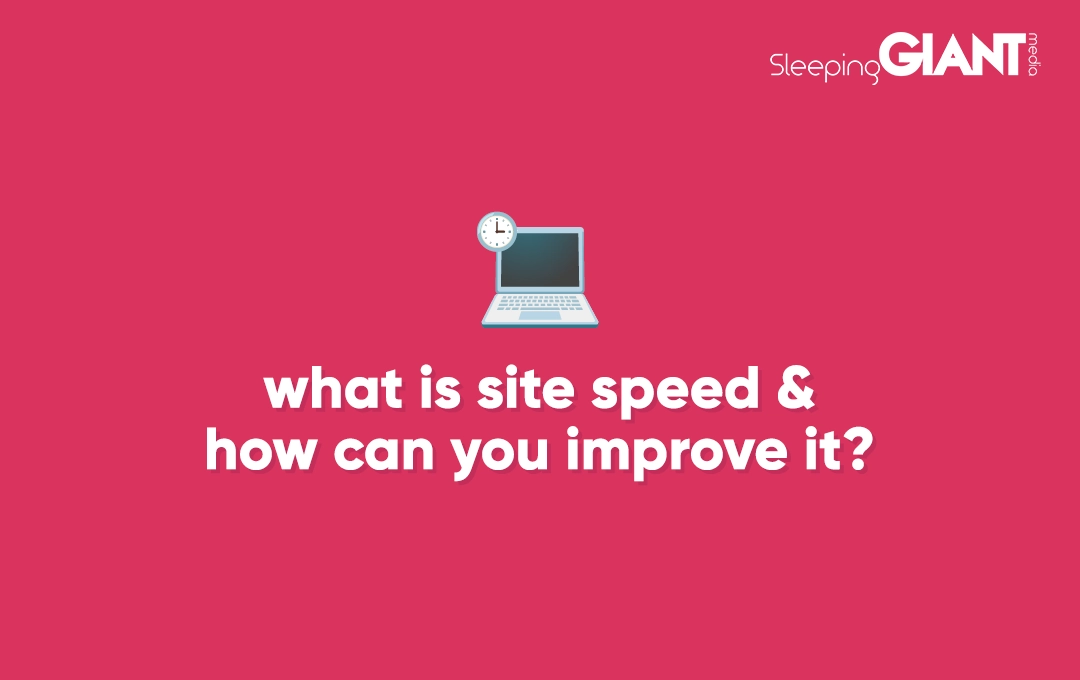
What is Site Speed & How Can You Improve it?
You’ve likely heard the viral statistic that humans have an attention span of 8.25 seconds (less than a goldfish). But, did you know that it takes just 3 seconds for 53% of mobile site users to abandon a page? Users are extremely impatient beings as it turns out.
So, if you thought site speed didn’t matter, think again.
In this blog, we advise you on how to keep up with your users’ short attention spans, running you through what site speed is, why it matters, and what you can do to keep users engaged if you are cursed with painfully-slow loading times.
And, if you’d prefer to have all of this presented to you in a visual format, why not watch our Giant Wednesday episode on it below.
What is site speed?
To put it simply, site speed is a measure of how long it takes a browser to fully load the functional web pages from a given site. This includes all on-page elements such as images, text, and any video files. Before we go any further, though, let’s clear something up…
What’s the difference between page speed & site speed?
In digital contexts, you may well also hear the term “page speed” being thrown around. While the two terms are sometimes used interchangeably, there is a notable difference.
While site speed refers to the average loading speed of all pages (or a representative sample of pages) on your website, page speed is simply the time it takes for one specific page to load.
How to measure site speed
How do you know if your site is super slow or lightning quick? Well, there are an impressive range of paid and free tools out there that can provide accurate readings of just how long your site takes to load.
- One option is loading up Google Analytics, clicking on the ‘Behaviour’ drop-down box, navigating to the ‘Site Speed’ section, and then opening up ‘overview’. Here, you’ll be able to see your average page load time. What’s more, you’ll be able to see how fast on average it takes to load on different browsers, such as Firefox.
- You can also use tools like PageSpeed Insights to explore specific web pages. This tool breaks down the various elements that make up page and site speed, giving you a great to-do list to help improve your speed yourself.
Why does site speed matter?
At this point, you may well be asking yourself how relevant site speed is to your content’s performance, what it means for the likes of SERP rankings, and how important is site speed for SEO?
How much does site speed affect SEO?
Let’s take a look, shall we? Site speed can affect the following SEO metrics.
Bounce rates
Although this metric has become less relevant as a ranking factor as of late, it is still useful to think about the time users are spending on your page and whether they are ‘bouncing’ or not.
It’s safe to say that pages with slow loading times usually cause impatient users to click off. And who can blame them? There’s been plenty of research to support this.
Google actually created a computer system modelled on the human brain called the ‘deep neural network’ which, with a scary 90% accuracy-rate, predicted the following:
- If your site takes between 1-3 seconds to load, the probability of a user ‘bouncing’ off your site increases by 32%
- A site speed of 1-5 seconds increases this bounce probability to 90%
1-6 seconds increases the probability by 106% - And, 1-10 seconds increases the probability of bouncing to 123%
So, if you care about people visiting your site, having a positive, enduring experience with you, and maybe even converting…then site speed is integral!
Just to back up the Google brain there, recent surveys have found that 47% of users expect a site to load in 2 seconds or less, and 52% of users are more likely to be loyal to a page with fast loading speed.
Kiss your conversions goodbye
To risk stating the obvious, the less time people spend on your site, the lower the chances of them completing an action – such as filling out a form, or downloading a resource from you.
It has been found that the first five seconds of page loading time have the highest impact on conversion rates. After this, conversion rates dwindle — significantly.
As an example, skilled.co found that:
- Pages that loaded in 2.4 seconds had a 1.9% conversion rate
- At 4.2 seconds, the conversion rate fell to <1%
- And, by 5.7+ seconds, the conversion rate was just 0.6%
Crawling
Having slow site and page speeds also means that less of your pages can get crawled by search engines, negatively impacting your indexation.
It’s been estimated that if your e-commerce site is making $100,000 (£76,160) a day, a one-second delay in your page speed can cost you $2.5 million (£1.9 million) every year.
When you put it that way, time really is money, huh?

Site speed as a ranking factor
You won’t be surprised to know that, when you put all of the above together, site speed comes to affect how well your individual pages and site as a whole performs in the SERPs.
So, if you’re plagued with slow page speeds and site speeds, what can you do?
How to improve your site speed
Reducing the load time taken by individual pages will have a knock-on effect on your site speed as a whole. Here are our 5 top tips for page speed optimisation:
Compress your images
A lot of the time, a slow load speed is caused by heavy file size photos and graphics on your page. Make sure you’re optimising and compressing your images, keeping them around 200KB (kilobytes) where possible.
You may need to strike a balance between quality and file size, though; don’t go putting a bunch of pixelated images on your site just so it loads quickly…
You can find out all about how to optimise images for your site in another of our blogs.
Don’t host your own videos
It goes without saying, but videos are pretty big, and people aren’t going to sit around all day waiting for them to load. As a best practice, use a third-party service such as YouTube or Vimeo and copy the embed code link to add the video to your site without the hefty file size.
Sort out your CSS
Look into optimising your CSS (AKA: ‘Cascading Style Sheets’, a computer programming language that dictates the structure of web pages) or ask your web development team to.
Your CSS will load in before anything visual appears to the user. As such, it is wise to streamline and get rid of any extra code to minimise your CSS files. Some platforms such as HubSpot and WordPress actually have options to minimise CSS automatically! So, it is worth checking that you’re using those options where available.
Enable browser caching
Lastly, an easy way to speed up your site for returning visitors is to enable ‘browser caching’.
This stores a bit of information from your site on the user’s computer, so, when they visit your site again, it will load faster for them than on their original visit — a bit like getting a wristband to re-enter a nightclub without queuing up again (only cooler).
Rethink your redirects
Having too many redirects may mean that a user is waiting a little bit longer to reach the page they’re after, increasing the chances of desertion and high bounce rates.
Want to know more about site speed?
Our team of SEO experts and content-writing whizzes are always on hand to help you optimise your pages and bring those pesky site speeds down. If you’re looking to pave the way for better user experience of your website, get in touch with our team today.
Or, to learn more about the ways in which your site could be streamlined, check out some of the other advice right here on our blog.
Want to know more?
Reach out and say hello. Come experience the GIANT side.
Blog
Everything you Need to Know About the March Core Update
We knew it wouldn’t be long before Google released their first core update of...
Giant Wednesday
How To Optimise Images For Websites
Digital Marketing, technology & business insights, how-to's and explainer...
Follow Us
Sign Up For More
Stay up to date with the latest happenings, learnings, events & more with our GIANT Newsletters.
Contact Us
Top Floor, The Civic Centre, Castle Hill Avenue, Folkestone CT20 2QY.




